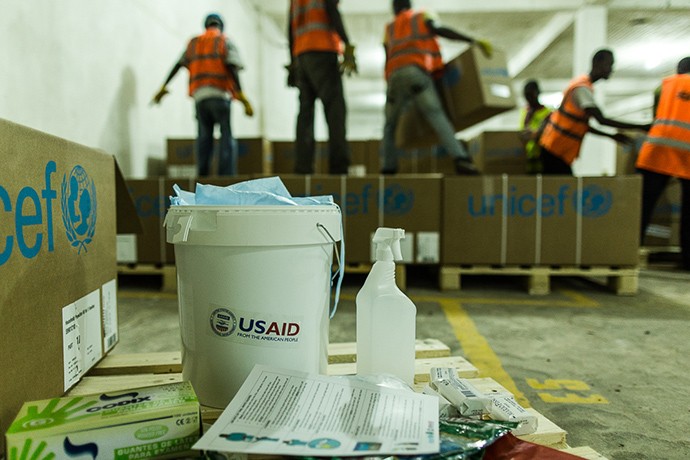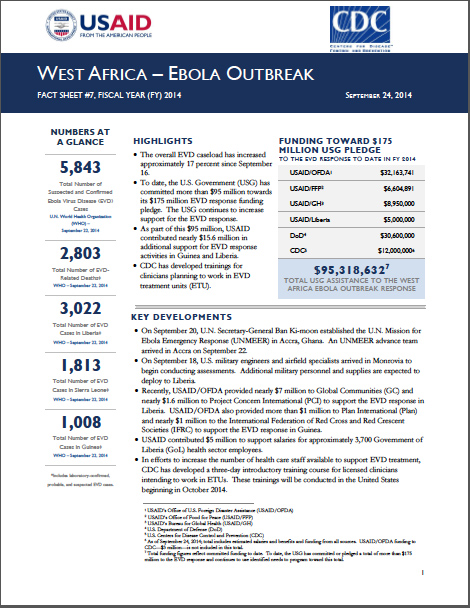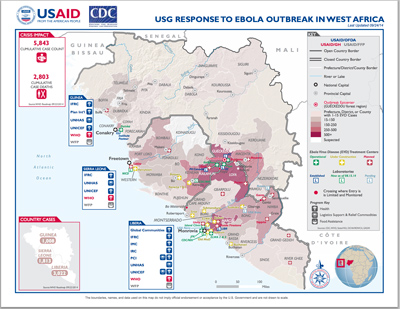Speeches Shim
September 24, 2014
HIGHLIGHTS
Ebola Response
Visit our main West Africa Ebola Outbreak page to learn more about how we're responding to the West Africa Ebola outbreak, and what you can do to help.
- The overall EVD caseload has increased approximately 17 percent since September 16.
- To date, the U.S. Government (USG) has committed more than $95 million towards its $175 million EVD response funding pledge. The USG continues to increase support for the EVD response.
- As part of this $95 million, USAID contributed nearly $15.6 million in additional support for EVD response activities in Guinea and Liberia.
- CDC has developed trainings for clinicians planning to work in EVD treatment units (ETU).
KEY DEVELOPMENTS
West Africa - Ebola Outbreak - Fact Sheet #7 ![]() (pdf - 255k)
(pdf - 255k)
On September 20, U.N. Secretary-General Ban Ki-moon established the U.N. Mission for Ebola Emergency Response (UNMEER) in Accra, Ghana. An UNMEER advance team arrived in Accra on September 22.
On September 18, U.S. military engineers and airfield specialists arrived in Monrovia to begin conducting assessments. Additional military personnel and supplies are expected to deploy to Liberia.
Recently, USAID/OFDA provided nearly $7 million to Global Communities (GC) and nearly $1.6 million to Project Concern International (PCI) to support the EVD response in Liberia. USAID/OFDA also provided more than $1 million to Plan International (Plan) and nearly $1 million to the International Federation of Red Cross and Red Crescent Societies (IFRC) to support the EVD response in Guinea.
USAID contributed $5 million to support salaries for approximately 3,700 Government of Liberia (GoL) health sector employees.
In efforts to increase the number of health care staff available to support EVD treatment, CDC has developed a three-day introductory training course for licensed clinicians intending to work in ETUs. These trainings will be conducted in the United States beginning in October 2014.
CURRENT SITUATION
The EVD caseload continues to increase rapidly. According to the CDC Morbidity and Mortality Weekly Report (MMWR), Liberia and Sierra Leone could have up to 1.4 million EVD cases by late January 2015 if the outbreak is allowed to progress without any intervention. However, CDC notes that MMWR figures are based on data from August and thus do not reflect recent efforts to improve EVD treatment and isolation, which are expected to slow the spread of the epidemic. The MMWR also predicted that the EVD outbreak could end by late January 2015 if approximately 70 percent of EVD patients were receiving appropriate care by late December 2014.
On September 20, WHO reported that the EVD outbreak in Nigeria was contained. No new EVD cases have been reported in Nigeria since September 8.
CDC and USAID continue to support EVD-affected countries to establish national and sub-national Emergency Operations Centers (EOC). USG experts have deployed to Guinea, Liberia, and Sierra Leone to provide technical guidance on setting up EOCs. All three countries currently have an incident manager, reporting to the President of the country, to lead EVD response efforts.
CDC partnered with major telecommunications companies in the affected countries to disseminate radio and television programs, public service announcements, text messages, and interactive voice response messages on EVD. The text messages include information about case counts, signs and symptoms of EVD, and how to sign up for daily tips.
CDC continues to provide infection control technical assistance, training, and support across the affected region. CDC is beginning to implement infection control train-the-trainer courses in affected countries.
To keep humanitarian workers safe while working in affected countries, CDC released guidance for humanitarian aid organizations on volunteer safety and health before, during, and after deployment.
Liberia
Suspected and confirmed EVD cases in Liberia increased by nearly 26 percent between September 9 and 17, from 2,407 cases to 3,022 cases, according to WHO. Of the 1,578 suspected EVD-related deaths in Liberia, WHO reports that 670 have been confirmed as EVD cases, as of September 17.
The 100-bed Island Clinic ETU—managed by WHO—opened on September 21. The Island Clinic ETU received 112 patients on the first day; it is the fourth ETU in Monrovia.
USAID/Liberia is providing $5 million in FY 2014 funding to support salaries for GoL civil servants working in the health sector. In collaboration with the GoL Ministry of Finance, USAID will finance the salaries of approximately 3,700 civil servant health workers for the next five months. The funding aims to alleviate fiscal burdens during the EVD outbreak and ensure continued staff coverage.
To expand burial team coverage nationwide, USAID/OFDA provided nearly $7 million to GC to scale up the scope and geographic reach of its existing burial team program. With support from USAID/OFDA, GC plans to support and manage 55 burial teams and 28 disinfection teams, active in all 15 counties of Liberia.
How Can I Help?
Qualified medical professionals: Learn how you can volunteer to help with the Ebola outbreak
USAID/OFDA provided nearly $1.6 million to PCI to support contact tracing, community social mobilization, and capacity building for health care workers in Bong and Nimba counties. PCI also plans to use funding from USAID/OFDA to procure relief commodities, such as personal protective equipment (PPE).
CDC technical experts in regional centers continue to strengthen surveillance efforts by supporting daily case reporting, training local county health directors, and assisting with contact tracing and data management. Incomplete data reporting remains a challenge in several areas. Staff in Monrovia are also directly assisting the GoL Ministry of Health and Social Welfare (MoHSW) with the compilation of daily case reports from across the country to form a national case count.
Sierra Leone
Suspected and confirmed EVD cases in Sierra Leone increased by nearly 12 percent between September 13 and 19, from 1,620 cases to 1,813 cases, according to the WHO. Of the 593 suspected EVD-related deaths in Sierra Leone, WHO reports that 545 have been confirmed as EVD cases, as of September 19.
The Government of Sierra Leone (GoSL) completed a three-day nationwide house-to-house campaign on September 21, reaching approximately 75 percent of the 1.5 million homes targeted. During the campaign, volunteer teams went door-to-door to discuss EVD and identify new cases. The GoSL reports that the teams identified approximately 130 EVD cases, buried nearly 100 bodies, and distributed approximately 1.5 million bars of soap.
In recent days, the U.S. Embassy in Freetown consigned 338 bags for safely transporting bodies, 50 rolls of plastic sheeting, and 3,420 sets of PPE to WHO and the U.N. Children’s Fund (UNICEF) in Sierra Leone.
CDC worked with UNICEF and Focus 1000 to develop a Knowledge, Attitudes, and Practices study in Sierra Leone. Findings from this study will be used to inform the development of new EVD prevention messages and awareness strategies.
CDC experts continue to support district-level epidemiologists to improve local-level data management and analysis. In-country data contractors are also currently supporting efforts to improve data entry to ensure data is readily available to inform response efforts.
Guinea
Suspected and confirmed EVD cases in Guinea increased by nearly 8 percent between September 13 and 20, from 936 cases to 1,008 cases, according to the WHO. Of the 632 suspected EVD-related deaths in Guinea, WHO reports that 465 have been confirmed as EVD cases, as of September 20.
Health actors continue to express concern regarding the increasingly insecure operating environment facing providers of EVD prevention and treatment assistance in Guinea. On September 18, the Government of Guinea (GoG) reported that local community members in Guinea’s Nzérékoré Prefecture killed eight EVD prevention workers—including health care workers, journalists, and local officials—conducting EVD awareness activities in the area. In response, a number of humanitarian organizations have relocated personnel from Macenta and Nzérékoré prefectures to other parts of Guinea.
The GoG announced plans to pre-position medical response stocks in six regions—Boké, Fouta Djallon, Guékédou, Kankan, Mamou, and Nzérékoré.
USAID/OFDA provided nearly $1 million to IFRC in Guinea to increase public awareness about EVD, as well as support epidemiological investigation, epidemic control, and clinical case management.
USAID/OFDA provided more than $1 million to Plan International to support social mobilization and contact tracing in Conakry, Nzérékoré, Guéckédou, Macenta, Yomou, Kissidougou, Coyah, Forécariah, Dubréka, and Télimélé prefectures.
LOGISTICS AND RELIEF COMMODITIES

The U.N. World Food Program (WFP) reports that the EVD response continues to be hampered by limited commercial transport, a lack of drivers to service ETUs, heavy seasonal rains, poor road conditions, a lack of available warehouse space, and border closures.
The Logistics Cluster—the coordinating body for humanitarian logistics activities, comprising U.N. agencies, non-governmental organizations, and other stakeholders—is activated in Liberia, but not in Guinea or Sierra Leone.
As of September 23, the USAID/OFDA-supported U.N. Humanitarian Air Service (UNHAS) has transported more than 380 humanitarian responders to EVD-affected areas. UNHAS has also transported more than 510 cubic meters of medical cargo in support of the EVD response.
USAID/OFDA continues to airlift relief commodities into EVD-affected countries. Most recently, USAID/OFDA airlifted 9,000 protection kits—containing a bucket, a sprayer, garbage bags, gloves, protective gowns, surgical makes, soap, and chlorine—designed to minimize EVD transmission risks for patients cared for outside of ETUs and in ECCs into Monrovia on September 24. USAID/OFDA and the DoD Defense Threat Reduction Agency also recently transported 74,000 medical gloves, 4,900 face shields, and 3,325 PPE suits to Monrovia, which were consigned to WHO.
FOOD SECURITY AND LIVELIHOODS
The U.N. World Food Program (WFP) Regional Emergency Operation (EMOP) plans to provide food to more than 1.3 million people in Guinea, Liberia, and Sierra Leone. As of September 23, WFP has delivered approximately 3,345 metric tons (MT) of food commodities to more than 180,000 people affected by the EVD outbreak in Guinea, Liberia, and Sierra Leone. To date, USAID/FFP has provided a total of $6.6 million in food commodities—including 5,629 MT of lentils, rice, soy-fortified bulgur, vegetable oil, and yellow split peas—to support the WFP EMOP.
The USAID-funded Famine Early Warning Systems Network (FEWS NET) predicts that, between September 2014 and March 2015, Stressed—IPC 2—food insecurity or higher is expected for at least 20 percent of the population in EVD-affected areas of Sierra Leone and Liberia. 8 A smaller proportion of the population is expected to face illness and market disruptions in Guinea, where FEWS NET projects Minimal—IPC 1—levels of food insecurity. FEWS NET reports that food insecurity will particularly affect households with ill family members and the urban poor.
INTERNATIONAL RESPONSE
Between April 1 and September 24, international donors provided more than $346.7 million to support EVD response activities in West Africa, according to the U.N. International contributions for the EVD response more than doubled between September 17 and 24, from $154.6 million.
On September 18, the U.N. Security Council (UNSC) unanimously voted to adopt UNSC Resolution 2177 declaring EVD a threat to international peace and security and calling on U.N. member states to provide resources and assistance, lift travel bans, and refrain from isolating EVD-affected countries.
On September 19, the governments of France and Germany announced plans to establish an air hub in Dakar, Senegal, to help move supplies and personnel into affected countries, according to media. The air hub will be able to transport approximately 100 MT of goods to affected countries weekly.
A U.N. Disasters Assessment and Coordination (UNDAC) team deployed to Liberia on September 18 to augment information management and humanitarian coordination efforts in the country. UNDAC’s mandate includes support to the National Ebola Command Center and humanitarian partners in operational coordination, information management, mapping the outbreak and response, and the launch of multi-sector humanitarian clusters.
WFP recently deployed an Information and Communications Technology (ICT) Response Team to West Africa to meet with humanitarian partners and coordinate inter-agency ICT activities.
PUBLIC DONATION INFORMATION
- The most effective way people can assist relief efforts is by making cash contributions to humanitarian organizations that are conducting relief operations. A list of humanitarian organizations that are accepting cash donations for disaster responses around the world can be found at www.interaction.org.
- USAID encourages cash donations because they allow aid professionals to procure the exact items needed (often in the affected region); reduce the burden on scarce resources (such as transportation routes, staff time, and warehouse space); can be transferred very quickly and without transportation costs; support the economy of the disaster-stricken region; and ensure culturally, dietary, and environmentally appropriate assistance.
More information can be found at:
- The Center for International Disaster Information: www.cidi.org or +1.202.821.1999.
- Information on relief activities of the humanitarian community can be found at www.reliefweb.int.
USAID/OFDA bulletins appear on the USAID website at what-we-



Comment
Make a general inquiry or suggest an improvement.